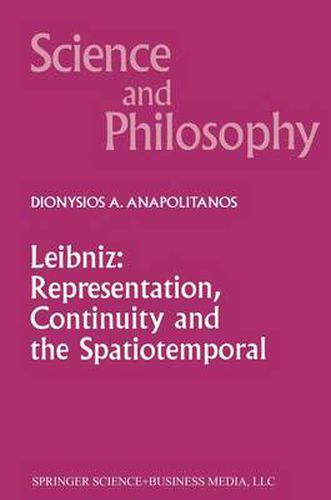Readings Newsletter
Become a Readings Member to make your shopping experience even easier.
Sign in or sign up for free!
You’re not far away from qualifying for FREE standard shipping within Australia
You’ve qualified for FREE standard shipping within Australia
The cart is loading…






This title is printed to order. This book may have been self-published. If so, we cannot guarantee the quality of the content. In the main most books will have gone through the editing process however some may not. We therefore suggest that you be aware of this before ordering this book. If in doubt check either the author or publisher’s details as we are unable to accept any returns unless they are faulty. Please contact us if you have any questions.
Anapolitanos critically examines and evaluates three basic characteristics of the Leibnizian metaphysical system: Leibniz’s version of representation; the principle of continuity; and space, time, and the phenomenally spatio-temporal. Chapter I discusses representation, especially as it refers to the connection between the real and the phenomenal levels of Leibniz’s system. Chapter II examines the principle of continuity, including continuity as a general feature of every level of Leibniz’s metaphysics. The position adopted is that the problem of the composition of the continuum played a central role on the development of Leibniz’s non-spatial and non-temporal monadic metaphysics. The machinery developed is then used to offer a new interpretation of Leibniz’ metaphysics of space and time. The notion of indirect representation is used to construct appropriate models that clarify the nature of the correspondence between the real and the phenomenal levels in the case of the relations ‘spatially between’ and ‘temporally between’, as well as in the cases of spatial and temporal density. Finally, Leibniz’s solution to the problem of the continuum is discussed, arguing that it is not entirely satisfactory. A non-anachronistic alternative is proposed, compatible with Leibniz’s metaphysics of substance.
$9.00 standard shipping within Australia
FREE standard shipping within Australia for orders over $100.00
Express & International shipping calculated at checkout
This title is printed to order. This book may have been self-published. If so, we cannot guarantee the quality of the content. In the main most books will have gone through the editing process however some may not. We therefore suggest that you be aware of this before ordering this book. If in doubt check either the author or publisher’s details as we are unable to accept any returns unless they are faulty. Please contact us if you have any questions.
Anapolitanos critically examines and evaluates three basic characteristics of the Leibnizian metaphysical system: Leibniz’s version of representation; the principle of continuity; and space, time, and the phenomenally spatio-temporal. Chapter I discusses representation, especially as it refers to the connection between the real and the phenomenal levels of Leibniz’s system. Chapter II examines the principle of continuity, including continuity as a general feature of every level of Leibniz’s metaphysics. The position adopted is that the problem of the composition of the continuum played a central role on the development of Leibniz’s non-spatial and non-temporal monadic metaphysics. The machinery developed is then used to offer a new interpretation of Leibniz’ metaphysics of space and time. The notion of indirect representation is used to construct appropriate models that clarify the nature of the correspondence between the real and the phenomenal levels in the case of the relations ‘spatially between’ and ‘temporally between’, as well as in the cases of spatial and temporal density. Finally, Leibniz’s solution to the problem of the continuum is discussed, arguing that it is not entirely satisfactory. A non-anachronistic alternative is proposed, compatible with Leibniz’s metaphysics of substance.